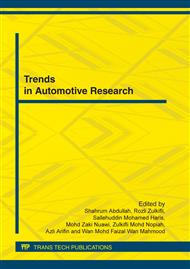p.275
p.280
p.285
p.290
p.295
p.300
p.305
p.310
p.316
Effect of Load Carriage on the Backpack Vibration System
Abstract:
Vibration causes many problems in human health, comfort and performance. While walking with a backpack, movement of the backpack relative to the body causes a vibration which behaves like a spring that moves up and down following the motion of the body. In order to analyse the backpacks response to trunk motion, a backpack vibration system has been developed in this study. A model of a backpack-human trunk system, which is represented by a mass-spring system with a damper, and a Fourier series as an external force, is used to describe the motion of the vibration system. The vibration system was analysed using constant values of damping and spring stiffness (c =1 and k = 5) but with different values of the mass of the backpack. Increasing the mass of the backpack from 10% of body weight to 15 and 20% of body weight increased the amplitude of both the displacement and velocity of the backpack vibration system. However, the frequencies of the vibration system decreased as the mass of the backpack increased.
Info:
Periodical:
Pages:
295-299
Citation:
Online since:
April 2012
Keywords:
Price:
Сopyright:
© 2012 Trans Tech Publications Ltd. All Rights Reserved
Share:
Citation:


